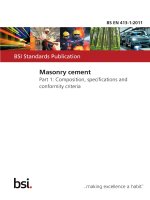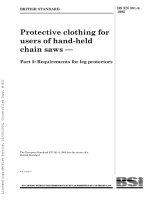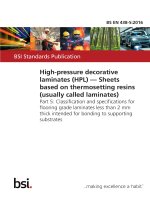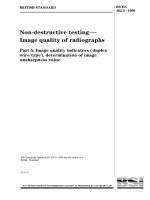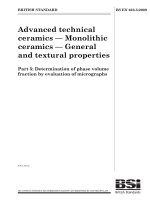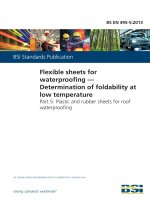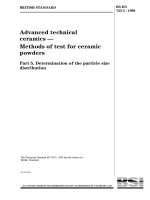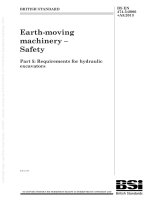Bsi bs en 62149 5 2011
Bạn đang xem bản rút gọn của tài liệu. Xem và tải ngay bản đầy đủ của tài liệu tại đây (1.17 MB, 32 trang )
BS EN 62149-5:2011
BSI Standards Publication
Fibre optic active components
and devices — Performance
standards
Part 5: ATM-PON transceivers with
LD driver and CDR ICs
BRITISH STANDARD
BS EN 62149-5:2011
National foreword
This British Standard is the UK implementation of EN 62149-5:2011. It is
identical to IEC 62149-5:2009. It supersedes BS EN 62149-5:2003, which is
withdrawn.
The UK participation in its preparation was entrusted by Technical Committee
GEL/86, Fibre optics, to Subcommittee GEL/86/3, Fibre optic systems and
active devices.
A list of organizations represented on this committee can be obtained on
request to its secretary.
This publication does not purport to include all the necessary provisions of a
contract. Users are responsible for its correct application.
© BSI 2011
ISBN 978 0 580 62225 0
ICS 33.180.20
Compliance with a British Standard cannot confer immunity from
legal obligations.
This British Standard was published under the authority of the Standards
Policy and Strategy Committee on 28 February 2011.
Amendments issued since publication
Amd. No.
Date
Text affected
BS EN 62149-5:2011
EUROPEAN STANDARD
EN 62149-5
NORME EUROPÉENNE
January 2011
EUROPÄISCHE NORM
ICS 33.180.20
Supersedes EN 62149-5:2003
English version
Fibre optic active components and devices Performance standards Part 5: ATM-PON transceivers with LD driver and CDR ICs
(IEC 62149-5:2009)
Composants et dispositifs actifs à fibres
optiques Normes de fonctionnement Partie 5: Emetteurs-récepteurs ATM-PON
avec programme de gestion LD et ICs
CDR
(CEI 62149-5:2009)
Aktive Lichtwellenleiterbauelemente und geräte Betriebsverhalten Teil 5: ATM-PON Sende- und
Empfangsmodule mit
Laserdiodentreiberschaltungen und Taktund Datenrückgewinnungs-ICs
(IEC 62149-5:2009)
This European Standard was approved by CENELEC on 2011-01-02. CENELEC members are bound to comply
with the CEN/CENELEC Internal Regulations which stipulate the conditions for giving this European Standard
the status of a national standard without any alteration.
Up-to-date lists and bibliographical references concerning such national standards may be obtained on
application to the Central Secretariat or to any CENELEC member.
This European Standard exists in three official versions (English, French, German). A version in any other
language made by translation under the responsibility of a CENELEC member into its own language and notified
to the Central Secretariat has the same status as the official versions.
CENELEC members are the national electrotechnical committees of Austria, Belgium, Bulgaria, Croatia, Cyprus,
the Czech Republic, Denmark, Estonia, Finland, France, Germany, Greece, Hungary, Iceland, Ireland, Italy,
Latvia, Lithuania, Luxembourg, Malta, the Netherlands, Norway, Poland, Portugal, Romania, Slovakia, Slovenia,
Spain, Sweden, Switzerland and the United Kingdom.
CENELEC
European Committee for Electrotechnical Standardization
Comité Européen de Normalisation Electrotechnique
Europäisches Komitee für Elektrotechnische Normung
Management Centre: Avenue Marnix 17, B - 1000 Brussels
© 2011 CENELEC -
All rights of exploitation in any form and by any means reserved worldwide for CENELEC members.
Ref. No. EN 62149-5:2011 E
BS EN 62149-5:2011
EN 62149-5:2011
Foreword
The text of document 86C/891/FDIS, future edition 2 of IEC 62149-5, prepared by SC 86C, Fibre optic
systems and active devices, of IEC TC 86, Fibre optics, was submitted to the IEC-CENELEC parallel vote
and was approved by CENELEC as EN 62149-5 on 2011-01-02.
This European Standard supersedes EN 62149-5:2003.
The main changes with respect to EN 62149-5:2003 are listed below:
– Normative references have been updated;
– Incorrect “Letter symbols” have been corrected;
– Some “Notes” in tables have been revised in order to harmonize with EN 62150-2:2004.
Attention is drawn to the possibility that some of the elements of this document may be the subject of
patent rights. CEN and CENELEC shall not be held responsible for identifying any or all such patent
rights.
The following dates were fixed:
– latest date by which the EN has to be implemented
at national level by publication of an identical
national standard or by endorsement
(dop)
2011-10-02
– latest date by which the national standards conflicting
with the EN have to be withdrawn
(dow)
2014-01-02
Annex ZA has been added by CENELEC.
__________
Endorsement notice
The text of the International Standard IEC 62149-5:2009 was approved by CENELEC as a European
Standard without any modification.
In the official version, for Bibliography, the following notes have to be added for the standards indicated:
IEC 60617 series
NOTE Harmonized in EN 60617 series (not modified).
IEC 60793 series
NOTE Harmonized in EN 60793 series (partially modified).
IEC 60794 series
NOTE Harmonized in EN 60794 series (not modified).
IEC 60825 series
NOTE Harmonized in EN 60825 series (not modified).
IEC 60874 series
NOTE Harmonized in EN 60874 series (not modified).
IEC 61076 series
NOTE Harmonized in EN 61076 series (not modified).
IEC 61280 series
NOTE Harmonized in EN 61280 series (not modified).
IEC 61281-1:1999
NOTE Harmonized as EN 61281-1:1999 (not modified).
IEC 61754 series
NOTE Harmonized in EN 61754 series (partially modified).
IEC 62007-1:1999
NOTE Harmonized as EN 62007-1:2000 (not modified).
IEC 62007-2:1999
NOTE Harmonized as EN 62007-2:2000 (not modified).
IEC 62148-1:2002
NOTE Harmonized as EN 62148-1:2002 (not modified).
__________
BS EN 62149-5:2011
EN 62149-5:2011
Annex ZA
(normative)
Normative references to international publications
with their corresponding European publications
The following referenced documents are indispensable for the application of this document. For dated
references, only the edition cited applies. For undated references, the latest edition of the referenced
document (including any amendments) applies.
NOTE When an international publication has been modified by common modifications, indicated by (mod), the relevant EN/HD
applies.
Publication
Year
Title
EN/HD
Year
IEC 60068-2-6
2007
Environmental testing Part 2-6: Tests - Test Fc: Vibration
(sinusoidal)
EN 60068-2-6
2008
IEC 60068-2-27
2008
Environmental testing Part 2-27: Tests - Test Ea and guidance:
Shock
EN 60068-2-27
2009
IEC 60825-1
2007
Safety of laser products Part 1: Equipment classification and
requirements
EN 60825-1
2007
IEC 60950-1 (mod) 2005
Information technology equipment - Safety Part 1: General requirements
EN 60950-1
+ A11
2006
2009
IEC 61000-6-3
-
EN 61000-6-3
Electromagnetic compatibility (EMC) Part 6-3: Generic standards - Emission
standard for residential, commercial and lightindustrial environments
-
IEC 61280-1-1
1998
Fibre optic communication subsystem basic EN 61280-1-1
test procedures Part 1-1: Test procedures for general
communication subsystems - Transmitter
output optical power measurement for singlemode optical fibre cable
1998
IEC 61280-1-3
1998
Fibre optic communication subsystem basic EN 61280-1-3
test procedures Part 1-3: Test procedures for general
communication subsystems - Central
wavelength and spectral width measurement
IEC 61280-2-2
2008
Fibre optic communication subsystem test
EN 61280-2-2
procedures Part 2-2: Digital systems - Optical eye pattern,
waveform and extinction ratio measurement
2008
IEC 61300-2-4
1995
Fibre optic interconnecting devices and
passive components - Basic test and
measurement procedures Part 2-4: Tests - Fibre/cable retention
EN 61300-2-4
1997
1)
EN 61280-1-3 is superseded by EN 61280-1-3:2010, which is based on IEC 61280-1-3:2010.
1)
1999
BS EN 62149-5:2011
EN 62149-5:2011
Publication
Year
Title
EN/HD
Year
IEC 61300-2-17
2003
Fibre optic interconnecting devices and
passive components - Basic test and
measurement procedures Part 2-17: Tests - Cold
EN 61300-2-17
2003
IEC 61300-2-18
2005
EN 61300-2-18
Fibre optic interconnecting devices and
passive components - Basic test and
measurement procedures Part 2-18: Tests - Dry heat - High temperature
endurance
2005
IEC 61300-2-19
2005
Fibre optic interconnecting devices and
passive components - Basic test and
measurement procedures Part 2-19: Tests - Damp heat (steady state)
EN 61300-2-19
2005
IEC 61300-2-22
2007
Fibre optic interconnecting devices and
passive components - Basic test and
measurement procedures Part 2-22: Tests - Change of temperature
EN 61300-2-22
2007
IEC 61300-3-6
2003
Fibre optic interconnecting devices and
passive components - Basic test and
measurement procedures Part 3-6: Examinations and measurements Return loss
EN 61300-3-6
2)
2003
IEC 61753-1
2007
Fibre optic interconnecting devices and
EN 61753-1
passive components performance standard Part 1: General and guidance for performance
standards
IEC/TR 61931
-
Fibre optic - Terminology
EN 62150-2
IEC 62150-2
2004
Fibre optic active components and devices Test and measurement procedures Part 2: ATM-PON transceivers
ITU-T
Recommendation
G.983.1
-
Broadband optical access systems based on Passive Optical Networks (PON)
2)
EN 61300-3-6 is superseded by EN 61300-3-6:2009, which is based on IEC 61300-3-6:2008.
3)
EN 62150-2 is superseded by EN 62150-2:2011, which is based on IEC 62150-2:2010.
2007
3)
2004
-
BS EN 62149-5:2011
62149-5 © IEC:2009
CONTENTS
INTRODUCTION.....................................................................................................................6
1
Scope ...............................................................................................................................7
2
Normative references .......................................................................................................7
3
Term, definitions and abbreviations ..................................................................................8
4
3.1 Terms and definitions ..............................................................................................8
3.2 Abbreviations ..........................................................................................................9
Classification ....................................................................................................................9
5
Product definition .............................................................................................................9
6
5.1 Description of transceiver module............................................................................9
5.2 Description of applied form .................................................................................... 10
5.3 Block diagram ....................................................................................................... 10
5.4 Absolute limiting rating .......................................................................................... 10
5.5 Functional specification ......................................................................................... 11
Testing ........................................................................................................................... 20
6.1
7
Characterization testing......................................................................................... 20
6.1.1 Characterization: transmitter section ......................................................... 21
6.1.2 Characterization: receiver section.............................................................. 22
6.2 Performance testing .............................................................................................. 22
Environmental specifications .......................................................................................... 23
7.1 General safety....................................................................................................... 23
7.2 Laser safety .......................................................................................................... 23
7.3 Electromagnetic emission ...................................................................................... 23
Annex A (informative) Measurement on tolerance to the reflected optical power
(Table 3, Item 13) ................................................................................................................. 24
Annex B (informative) Logic level of alarm and shutdown signal .......................................... 26
Bibliography.......................................................................................................................... 27
Figure 1 – Functional block diagram (example) ..................................................................... 10
Figure 2 – Relationship of phase between clock and data signals ......................................... 18
Figure 3 – Recommended electrical circuit diagram for LVTTL-type interface (example) ....... 19
Figure 4 – Schematic drawing for defining launched optical power without input to
transmitter ............................................................................................................................ 19
Figure 5 – Schematic drawing for defining launched optical power without input to
transmitter ............................................................................................................................ 20
Figure A.1 – Model for incidence into ONU receiver .............................................................. 24
Figure A.2 – An example system to measure tolerance to the reflected optical power ........... 24
Figure A.3 – A recommended system to measure tolerance to the reflected optical
power ................................................................................................................................... 25
Table 1 – Absolute maximum ratings .................................................................................... 11
Table 2 – Operating environment .......................................................................................... 12
Table 3 – Electrical and optical characteristics...................................................................... 13
Table 4 – Electrical interface characteristics (PECL type) ..................................................... 16
BS EN 62149-5:2011
62149-5 © IEC:2009
Table 5 – Electrical interface characteristics (LVTTL type) .................................................... 17
Table 6 – Electrical interface characteristics of alarm output voltage (PECL type)................. 17
Table 7 – Electrical interface characteristics of alarm output voltage (LVTTL type) ............... 17
Table 8 – Electrical interface characteristics of shutdown input voltage (both PECL
and LVTTL types) ................................................................................................................. 18
Table 9 – Transmitter section characterization tests ............................................................. 21
Table 10 – Receiver section characterization tests ............................................................... 22
Table 11 – Performance testing plan..................................................................................... 23
BS EN 62149-5:2011
–6–
62149-5 © IEC:2009
INTRODUCTION
Fibre optic transceivers are used to convert electrical signals into optical signals and vice
versa. The optical performance criteria are generally well specified for a number of
internationally agreed applications areas such as ITU-T Recommendation G.983.1 and IEEE
802.3. This standard aims to assure inter-changeability in performance between fibre optic
transceivers for ATM-PON systems supplied by different manufacturers, but does not
guarantee operation between fibre optic transceivers.
Manufacturers using the standards are responsible for meeting the required performance
and/or reliability and quality assurance under a recognized scheme.
BS EN 62149-5:2011
62149-5 © IEC:2009
–7–
FIBRE OPTIC ACTIVE COMPONENTS AND DEVICES –
PERFORMANCE STANDARDS –
Part 5: ATM-PON transceivers with LD driver and CDR ICs
1
Scope
This part of IEC 62149 specifies performance on the transceiver modules for asynchronoustransfer-mode passive optical network (ATM-PON) systems recommended by the International
Telecommunication Union (ITU) in ITU-T Recommendation G.983.1.
2
Normative references
The following referenced documents are indispensable for the application of this document.
For dated references, only the edition cited applies. For undated references, the latest edition
of the referenced document (including any amendments) applies.
IEC 60068-2-6:2007, Environmental testing – Part 2-6: Tests – Test Fc: Vibration (sinusoidal)
IEC 60068-2-27:2008, Environmental testing – Part 2-27: Tests – Test Ea and guidance:
Shock
IEC 60825-1:2007, Safety of laser products – Part 1: Equipment classification and
requirements
IEC 60950-1:2005, Information technology equipment – Safety – Part 1: General requirements
IEC 61000-6-3, Electromagnetic compatibility (EMC) – Part 6-3: Generic standards –
Emission standard for residential, commercial and light-industrial environments
IEC 61280-1-1:1998, Fibre optic communication subsystem basic test procedures – Part 1-1:
Test procedures for general communication subsystems – Transmitter output optical power
measurement for single-mode optical fibre cable
IEC 61280-1-3:1998, Fibre optic communication subsystem basic test procedures – Part 1-3:
Test procedures for general communication subsystems – Central wavelength and spectral
width measurement
IEC 61280-2-2:2008, Fibre optic communication subsystem test procedures – Part 2-2: Digital
systems – Optical eye pattern, waveform and extinction ratio measurement
IEC 61300-2-4:1995, Fibre optic interconnecting devices and passive components – Basic
test and measurement procedures – Part 2-4: Tests – Fibre/cable retention
IEC 61300-2-17:2003, Fibre optic interconnecting devices and passive components – Basic
test and measurement procedures – Part 2-17: Tests – Cold
IEC 61300-2-18:2005, Fibre optic interconnecting devices and passive components – Basic
test and measurement procedures – Part 2-18: Tests – Dry heat – High temperature
endurance
BS EN 62149-5:2011
–8–
62149-5 © IEC:2009
IEC 61300-2-19:2005, Fibre optic interconnecting devices and passive components – Basic
test and measurement procedures – Part 2-19: Tests – Damp heat (steady state)
IEC 61300-2-22:2007, Fibre optic interconnecting devices and passive components – Basic
test and measurement procedures – Part 2-22: Tests – Change of temperature
IEC 61300-3-6:2003, Fibre optic interconnecting devices and passive components – Basic
test and measurement procedures – Part 3-6: Examinations and measurements – Return loss
IEC 61753-1:2007, Fibre optic interconnecting devices and passive components performance
standard – Part 1: General and guidance for performance standards
IEC 61931, Fibre optic – Terminology
IEC62150-2:2004, Fibre optic active components and devices – Test and measurement
procedures - Part 2: ATM-PON transceivers
ITU-T Recommendation G.983.1: Broadband optical access systems based on Passive
Optical Networks (PON)
3
Term, definitions and abbreviations
For the purposes of this document, the following terms, definitions and abbreviations apply.
Further terminology concerning related physical concepts, types of devices, general terms,
and terms related to ratings and characteristics can be found in IEC 61931.
It is also recommended to refer to ITU-T Recommendation G.983.1.
3.1
Terms and definitions
3.1.1
optical access network
OAN
set of access links sharing the same network-side interfaces and supported by optical access
transmission systems.
NOTE
The OAN may include a number of ODNs connected to the same OLT.
3.1.2
optical distribution network
ODN
apparatus or component that provides the optical transmission means from the OLT to the
users, and vice versa. It utilizes passive optical components
3.1.3
optical line termination
OLT
apparatus that provides the network-side interface of the OAN, and is connected to one or
more ODNs
3.1.4
optical network unit
ONU
apparatus that provides (directly or remotely) the user-side interface of the OAN, and is
connected to the ODN
BS EN 62149-5:2011
62149-5 © IEC:2009
3.2
–9–
Abbreviations
ATM-PON
Asynchronous transfer mode passive optical network
ATT
Attenuator
BER
Bit error ratio
CDR
Clock and data recovery
DUT
Device under test
ERD
Error ratio detector
EX
Extinction ratio
FTT Cab/C/B/H
Fibre to the cabinet/curb/building/home
IC
Integrated circuit
LD
Laser diode
MLM
Multi-longitudinal mode
PPG
Pulse pattern generator
RMS
Root mean square
SLM
Single-longitudinal modes
4
Classification
Fibre optic transceiver modules are classified into 5 types of forms according to the
combination of mating types of electrical and optical interfaces (for details, see IEC 62148-1).
Those combinations include the following:
Type 1: Fibre optic connector interface with direct solderable type electrical terminals.
Type 2: Fibre optic connector interface with plug-in type electrical terminals.
Type 3: Fibre optic pigtail interface with direct solderable type electrical terminals.
Type 4: Fibre optic pigtail interface with plug-in type electrical terminals.
Type 5: Modules are not classified into type 1 to type 4. (A typical example is a module that
has both electrical connectors and non-connector type terminals as an electrical
interface such as a coaxial connector for signal and lead terminals for the power
supply.)
5
Product definition
5.1
Description of transceiver module
Information on the following devices constituting the optical transceiver module shall be
stated. This statement shall include details of technologies. For example, technologies used
for ICs such as CMOS, bipolar, etc., shall be described.
•
•
For a transmitter:
–
laser diode (in this description, a single- or a multi-longitudinal mode type shall be
specified);
–
monitoring photodiode;
–
driver IC;
–
thermal sensor (where appropriate).
For a receiver:
–
photodiode;
–
pre-amp IC;
BS EN 62149-5:2011
62149-5 â IEC:2009
10
ã
For a wavelength division multiplexer device:
–
•
technology used for this device.
For a package:
–
5.2
data/clock recovery IC.
refer to the IEC document number standardized as a package interface standard.
Description of applied form
According to ITU-T Recommendation G.983.1, applied form of nominal bit rate, class (class B
or class C), applied unit (ONU or OLT), and the number of fibres (one for duplex working or
two for simplex working) shall be stated.
5.3
Block diagram
Block diagram or equivalent circuit information on the optical transceiver module shall be
given.
The following terminals may be distinguished:
•
supply terminals, i.e., terminals intended to be connected to the power supplies;
•
input and output terminals, i.e., terminals into or out of which signals are passed.
The term “signal” includes both pulse and more complex waveforms, and includes strobe or
control pulses.
Power
supply
Optical
input/output
Data input
Data output
Clock input
Clock output
Bias control
(where appropriate)
Shutdown
Alarm
Earth
IEC 1489/09
Figure 1 – Functional block diagram (example)
5.4
Absolute limiting rating
Absolute limiting (maximum) ratings imply that no catastrophic damage will occur if the
product is subjected to these ratings for short periods, provided each limiting parameter is in
isolation and all other parameters have values within the normal performance parameters. It
should not be assumed that limiting values of more than one parameter could be applied at
any one time.
BS EN 62149-5:2011
62149-5 © IEC:2009
– 11 –
Table 1 – Absolute maximum ratings
Items
Condition
Letter
symbol
Requirements
Minimum
Maximum
Units
Storage temperature a
T stg
–40
85
°C
Storage humidity
H stg
5
95
%
r
30
Bend radius of pigtail for type 3, 4, and 5
transceivers (at specified distance from the
case)
mm
Shock b
Pulse cycle:
18 ms
3 times/axis
300
m/s 2
Vibration c
10 Hz -55 Hz,
3 axes,
1,5 mm, 2 h
100
m/s 2
5
100
N
4,0
V
Tensile force on devices with pigtail
Buffer-coated fibre d
Reinforced fibre d
F
Electrical limiting values
– Power supply voltage
V SUPmax
–0,5
V INmax
–0,5
V sup
V
– Output voltage
V OUTmax
0
V sup +0,5
V
– Output current
PECL interface
LVTTL interface
I OUTmax
0
–20
50
20
mA
–5
dBm
– Input voltage
Optical limiting values
– Permissible input power
P in
a
Ambient temperature and humidity for outdoor ONU is under further study in ITU-T Recommendation
G.983.1, thus these specifications may be varied in the future.
b
IEC 60068-2-27 shall be referred to for detail.
c
IEC 60068-2-6 shall be referred to for detail.
d
For requirements see IEC 61753-1.
5.5
Functional specification
Electro-optical characteristics for the items in Table 3 shall be satisfied at the operating
environmental conditions specified in Table 2.
NOTE
Optical characteristics specified in ITU-T Recommendation G.983.1 should be satisfied.
Each electrical and optical characteristics of this clause shall be measured under conditions
specified in each reference.
Each electrical and optical characteristic of this clause shall be stated under specified worstcase conditions, with respect to the recommended range of operating conditions as stated.
The measuring method of each electrical and optical characteristics specified in Table 3 shall
be measured based on the method stated in the reference of each row.
BS EN 62149-5:2011
62149-5 © IEC:2009
– 12 –
Table 2 – Operating environment
Items
Letter
symbol
Requirements
Units
Minimum
Typical
Maximum
3,3
3,465
V
Power supply voltage
V SUP
3,135
Operating case temperature a
T case
–5
75
°C
Ambient humidity a
RH
5
95
%
a
Operating case temperature and humidity for outdoor ONU is under further study in ITU-T
Recommendation G.983.1, thus these specifications may be varied in the future.
Maximum reflectance, measured at receiver wavelength
Tolerance to the reflected optical power c
Clock input voltage (high)
Clock input voltage (low)
Clock input voltage (swing centre)
Data input voltage (high)
Data input voltage (low)
Data input voltage (swing centre)
12
13
14
15
16
17
18
19
See Tables 4 and 5
See Tables 4 and 5
See Tables 4 and 5
See Tables 4 and 5
See Tables 4 and 5
See Tables 4 and 5
–20
10
–30
–33
dB
dB
dBm
dBm
dB
dB
nm
nm
dB
nm
dBm
Mb/s
Units
ITU-T G.957
Appendix III
IEC 61300-3-6, 4.1
IEC 62150-2
IEC 62150-2
IEC 61300-3-6, 4.1
IEC 61280-1-3
IEC 61280-1-3
IEC 61280-1-3
IEC 61280-2-2
IEC 61280-1-3
IEC 61280-1-1
Reference
62149-5 © IEC:2009
R RX
S
Receiver sensitivity:
– Class B
– Class C
11
–8
–11
SO
9
Receiver overload:
– Class B
– Class C
For SLM laser, minimum side mode suppression ratio
8
1,0
Δλ
10
For SLM laser, maximum -20 dB width
7
5,8
1 360
+2
+4
Maximum
Δλ
10
–6
For MLM laser, maximum RMS width
6
Ex
R TX
Extinction ratio
5
–
Maximum reflectance, measured at transmitter wavelength
Mask of transmitter eye
4
1260
λ
30
Transmitter wavelength
3
–4
–2
155,52
Typical
Requirements
Minimum
P mean
B
Letter symbol
SMSR
Mean launched power a
– Class B
– Class C
2
diagram b
Nominal bit rate
Items
1
Item number
Table 3 – Electrical and optical characteristics
BS EN 62149-5:2011
– 13 –
See Tables 6 and 7
Alarm output voltage (high) d
Alarm output voltage (low) d
24
25
g
See Tables 6 and 7
Data output voltage (low)
23
Jitter tolerance b
Jitter transfer b
35
36
32
Jitter generation b
Tolerance to the transmitter incident light power g
31
Consecutive identical digit
Launched optical power without input to transmitter
- Class B
- Class C
30
34
Line code
29
33
–15
Bias control voltage (low) f
28
immunity b
–40
–43
Bias control voltage (high) f
27
Scrambled NRZ
See Table 8
Shutdown input voltage (low) e
V BiasL
See Table 8
Shutdown input voltage
26
See Tables 4 and 5
(high) e
V BiasH
See Tables 4 and 5
Data output voltage (high)
22
See Tables 4 and 5
Clock output voltage (low)
Typical
Requirements
See Tables 4 and 5
Minim
um
21
Letter symbol
Clock output voltage (high)
Items
20
Item number
Table 3 (continued)
Maxi
mum
dB
dBm
Units
IEC 61280-1-1
IEC 62150 – 2
IEC 62150 – 2
IEC 62150 – 2
IEC 62150 – 2
Reference
BS EN 62149-5:2011
– 14 –
62149-5 © IEC:2009
Pseudo random data shall be put into the transmitter according to the specification of 8.2.6.3 of ITU-T Recommendation G.983.1.
These items shall be specified so as to meet the specifications of ITU-T Recommendation G. 983.1.
This item shall be measured based on the measuring method described in the reference. See Annex A for more detail.
With logic ‘Low’, an alarm signal is effective. The alarm test shall be done whether logic ‘Low’ is put out when no optical power is launched to the transceiver,
and logic ‘High’ is put out when optical power more than that specified in Item 11 is launched to the transceiver (see Annex B).
With logic ‘Low’, a shutdown signal is effective. The shutdown test shall be done whether optical power less than that specified in Item 31 is launched when
logic ‘Low’ is put into the ‘Shutdown’ terminal, and optical powerwithin the range specified in Item 2 is launched when logic ‘High’ is put into the ‘Shutdown’
terminal (see Annex B).
These items shall be specified between vendors and users.
Measurement methods on these items are stated in this clause.
a
b
c
d
e
f
g
Table 3 (continued)
BS EN 62149-5:2011
62149-5 © IEC:2009
– 15 –
BS EN 62149-5:2011
62149-5 © IEC:2009
– 16 –
The clock and data input/output interface shall be satisfied with either the specification listed
in Table 4 or that in Table 5. The interface specifications characterized by each table are
normally referred to as PECL and LVTTL interfaces, respectively. New interface dimensions
will be added properly.
Table 4 – Electrical interface characteristics (PECL type)
Items
Letter
symbol
Requirements
Minimum
Typical
Units
Maximum
Clock input voltage (high)
V CINH
- V SUP
–1,17
Clock input voltage (low)
V CINL
- V SUP
–1,81
Data input voltage (high)
V DINH
- V SUP
–1,17
–0,88
V
–1,81
–1,43
V
Data input voltage (low)
V DINL
- V sup
–0,88
–1,43
V
V
Clock output voltage (high) a
V COUTH
- V SUP
–0,96
V
Clock output voltage (low) a
V COUTL
- V SUP
–1,71
V
Data output voltage (high) a
V DOUTH
- V SUP
–0,96
V
Data output voltage (low) a
V DOUTL
- V SUP
–1,71
V
a
Outputs terminated to V SUP –2V.
BS EN 62149-5:2011
62149-5 © IEC:2009
– 17 –
Table 5 – Electrical interface characteristics (LVTTL type)
Requirements
Units
Letter
symbol
Minimum
Clock input voltage (high)
V CINH
V CINL
+0,3
V SUP
V
Clock input voltage (low)
V CINL
0
V CINH
–0,3
V
V Ccenter
V SUP /2
–0,1
V SUP /2
+0,1
V
Data input voltage (high)
V DINH
V DINL
+0,3
V SUP
V
Data input voltage (low)
V DINL
0
V DINH
+0,3
V
V SUP /2
+0,1
V
Items
Clock input voltage (swing centre)
Data input voltage (swing centre)
V Dcenter
V SUP /2
–0,1
Clock output voltage (high) a
V COUTH
V TT
+0,4
Clock output voltage (low) a
V COUTL
Data output voltage (high) a
V DOUTH
Data output voltage (low) a
V DOUTL
a
Typical
Maximum
V
V TT
–0,4
V TT
+0,4
V
V
V TT
–0,4
V
V TT = 1,5 V to 1,8 V.
Alarm output interface shall be satisfied with either specification listed in Table 6 or that in
Table 7. The interface specifications characterized by each table are normally referred to as
PECL and LVTTL interfaces, respectively. New interface dimensions will be added properly.
Table 6 – Electrical interface characteristics of alarm output voltage (PECL type)
Letter
symbol
Items
Alarm output voltage (high)
a
Alarm output voltage (low) a
a
V ALH
Requirements
Minimum
Typical
Units
Maximum
2,4
V
V ALL
0,4
V
Test shall be performed with current at high level ( I ALH ) = –2 mA and current at low level ( I ALL )
= 2 mA at V SUP between 3,135 V and 3,465 V.
Table 7 – Electrical interface characteristics of alarm output voltage (LVTTL type)
Items
Alarm output voltage (high)
Alarm output voltage (low) a
a
a
Requirements
Letter
symbol
Minimum
V ALH
V SUP
- 0,2
V ALL
Typical
Units
Maximum
V
0,2
V
Test shall be performed with current at high level ( I ALH ) = –100 μA and current at low level
( I ALL ) = 100 μA at V SUP between 3,135 V and 3,465 V.
Shutdown input interface shall be satisfied with either specifications listed in Table 8. New
interface dimensions will be added properly.
BS EN 62149-5:2011
62149-5 © IEC:2009
– 18 –
Table 8 – Electrical interface characteristics of shutdown input voltage
(both PECL and LVTTL types)
Requirements
Letter
symbol
Minimum
Shutdown input voltage (high) a
V SDH
2,0
Shutdown input voltage (low) a
V SDL
–0,3
Items
a
Typical
Units
Maximum
V SUP
+ 0,3
0,8
V
V
Test shall be performed with V SUP between 3,135 V and 3,465 V.
NOTE The interfaces listed in Tables 6, 7 and 8 refer to EIA/JEDEC JESD8-B, with the exception of power supply
voltage V SUP that is definitely specified in Table 2.
Relationship of the phase between clock and data signals is shown in Figure 2. Phase of data
signals are timed so that data signals are latched at a fall time of clock.
Clock
Data
IEC 1490/09
Figure 2 – Relationship of phase between clock and data signals
Examples of recommended electrical circuit diagrams for LVTTL-type interface are shown in
Figure 3.
BS EN 62149-5:2011
62149-5 © IEC:2009
– 19 –
VTT
Clock/Data
Output
50 Ω
82 Ω
Clock/Data
Input
50 Ω
a)
Vout/Vin
IEC 1491/09
VCC
Clock/Data
Input
Clock/Data
Output
100 Ω
100 Ω
100 Ω
100 Ω
82 Ω
b)
Vout/Vin
Ground
IEC 1492/09
Figure 3 – Recommended electrical circuit diagram for LVTTL-type interface (example)
Optical power level
Launched optical power without input to transmitter (Table 3, Item 31) is schematically
defined in Figure 4. The measuring method of the power shall basically follow IEC 61280-1-1,
but it shall be specified in detail between vendors and users.
Burst signals
Launched optical power
without input to transmitter
0
IEC 1493/09
Figure 4 – Schematic drawing for defining launched optical power
without input to transmitter
Tolerance to the transmitter incident light power (Table 3, Item 32) is measured, for example,
by an experimental setup shown in Figure 5. The value of reflection at the reflector is set so
that incident light power back to the transmitter is 15 dB less than that of mean transmitter
BS EN 62149-5:2011
62149-5 © IEC:2009
– 20 –
launching power. Pass/fall criteria depend on whether or not the waveform of signals
transmitted from the DUT and monitored at the waveform monitor satisfies the eye mask
specified in Table 3, Item 4.
Waveform
monitor
High return loss
termination
Optical
coupler
Reflector
DUT
–15dB
IEC 1494/09
Figure 5 – Schematic drawing for defining launched optical power
without input to transmitter
6
Testing
Initial characterization and qualification shall be undertaken. Qualification maintenance is
carried using periodic testing programs. Test conditions for all tests unless otherwise stated
are 25 °C ± 2 °C
6.1
Characterization testing
Characterization testing including both transmitter and receiver sections shall be carried out
based on the specifications listed in Table 9 for the transmitter section and Table 10 for the
receiver section. These testing shall be carried out on at the least 11 products taken from a
manufacturing lot for each user. The testing lot shall be specified by each supplier. If any
changes occur in the design of the transceiver, the testing shall be carried out again.
BS EN 62149-5:2011
62149-5 © IEC:2009
6.1.1
– 21 –
Characterization: transmitter section
Table 9 – Transmitter section characterization tests
Parameters
Test conditions
Test limit
Minimum
Test limit
Maximum
Unit
dBm
As a minimum, 11 devices taken from a
manufacturing lot for each user to be
measured at case temperatures of (–5 ±
2) °C, (25 ± 2) °C and (75 ± 2) °C and V cc at
( V nom –5 %) V, ( V nom ) V and ( V nom + 5 %) V
Mean launched power
Central wavelength
Single-mode fibre, PRBS 2 23 – 1 at
155,52 Mbit/s modulation
–
Class B
–4,0
+2,0
–
Class C
–2,0
+4,0
1 260
1 360
PRBS 2 23 – 1at 155,52 Mbit/s modulation
nm
PRBS 2 23 – 1 at 155,52 Mbit/s modulation
Spectral width
–
MLM laser
5,8
–
SLM laser
1,0
Extinction ratio
155,52 Mbit/s square wave
Mask test of eye diagram a
Fourth-order Thomson filter (Cut-off frequency
is (0,75 × 155,52) MHz), PRBS 2 23 – 1 at
155,52 Mbit/s
Shutdown test of launched
power
a
10
No hits
nm
dB
No hits
PRBS 2 23 – 1 at 155,52 Mbit/s modulation,
Shutdown input voltage: low level
–
Class B
–40
–
Class C
–43
dBm
Mask of the eye diagrams for downstream and upstream transmissions are specified in ITU-T Recommendation
G.983.1.
BS EN 62149-5:2011
62149-5 © IEC:2009
– 22 –
6.1.2
Characterization: receiver section
Table 10 – Receiver section characterization tests
Parameters
Test conditions
Test limit
Minimum
Test limit
Maximum
Unit
As minimum, 11 devices taken from an
initial manufacturing lot to be measured
at case temperatures of (–5 ± 2) °C,
(25 ± 2) °C and (75 ± 2) °C and V cc at
( V nom – 5 %) V, ( V nom ) V and
(V nom + 5 %) V
Sensitivity at 1E-10
BER
Overload at 1E-10
BER
PRBS modulation NRZ at 155,52 Mbit/s
assuming 10dB extinction ratio source
–
Class B
–30,0
–
Class C
–33,0
dBm
PRBS modulation NRZ at 155,52 Mbit/s
assuming 10 dB extinction ratio source
–
Class B
–8
–
Class C
–11
dBm
PRBS modulation NRZ at 155,52 Mbit/s
assuming 10 dB extinction ratio source
Alarm on threshold a
a
6.2
–
Class B
–30,0
–
Class C
–33,0
dBm
Alarm signal is effective with logic ‘low’ specified in Tables 6 and 7 when optical power less than
that of threshold is launched to the transceiver.
Performance testing
Performance testing is undertaken to assure reliability of products when characterization
testing is complete. The testing items, definite testing conditions and pass/fail criteria are
listed in Table 11. This testing shall be carried out on at least 11 products taken from a
manufacturing lot for each user. The testing lot shall be specified by each supplier. The
products may be new or sourced from a previous test.
